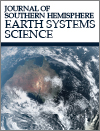Journal of Southern Hemisphere Earth Systems Science
Volume 72
Number 2 2022
The performance of the latest ACCESS climate and earth system models, developed for the coupled model intercomparison project phase 6 (CMIP6), is investigated using observational and reanalysis data. We analyse the simulated climate variability and change for the historical period and find that the two ACCESS models perform satisfactorily compared to other state-of-the-science climate models. This work is expected to facilitate further analyses of the existing simulations and designing of new model experiments to address important climate related problems.
Simulation data from four Australian global climate and Earth System Models (ACCESS) have been submitted to the recent phase of the Coupled Model Intercomparison Project (CMIP6). We detail the experimental setups and methodology used to build the ensemble of simulations, and we perform a high-level analysis of some of the simulations performed. The data generated from these simulations will underpin global and regional climate research for many years, including the Sixth Assessment Report from the Intergovernmental Panel on Climate Change.
The expansion over the last decade of observations in Australia with 1-min temporal resolution allows an assessment of temperature variations over very short periods. The mean difference between the highest and lowest temperatures within 1 min is greatest in the middle of the day and at arid and semi-arid locations, and greater in summer than winter at most locations. In addition to any inherent interest, these results have applications in data quality control, and in assessing when temporal gaps in observations can be infilled with a given confidence level.
The Waroona fire burned 69 000 ha south of Perth in January 2016. There were two fatalities and 170 homes were lost. The coupled fire–atmosphere model ACCESS-Fire has been run to explore the extreme fire behaviour that was observed. The simulations resolve the deep moist convection as an indicator of pyrocumulonimbus cloud. Fire–atmosphere interactions surrounding the evening ember storm provided an environment conducive to mass spotting. Suggestions are made for applying the learnings from this case to operational practice.
The summer of 2019–2020 saw unprecedented bushfires in eastern Australia. We examine the weather during several eastern Victoria fire runs in that summer, including the ~80-km fire run of the Upper Murray fire in less than 24 h, and the fires that damaged townships of Sarsfield, Clifton Creek, Corryong and Mallacoota. Several of these runs occurred under record or near record high FFDI values, and unusually occurred overnight. We document how the ranges and the ocean affect fire behaviour in eastern Victoria.
 , Arnold Sullivan, Martin Dix
, Arnold Sullivan, Martin Dix  , Daohua Bi, Chloe Mackallah
, Daohua Bi, Chloe Mackallah  , Tilo Ziehn, Peter Dobrohotoff
, Tilo Ziehn, Peter Dobrohotoff  , Siobhan O’Farrell, Ian N. Harman, Roger Bodman and Simon Marsland
, Siobhan O’Farrell, Ian N. Harman, Roger Bodman and Simon Marsland



